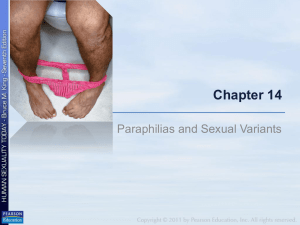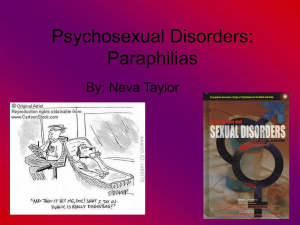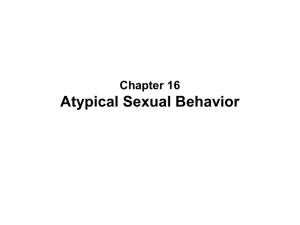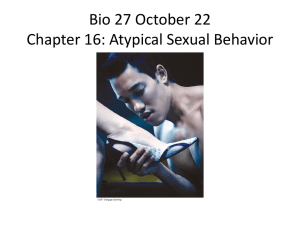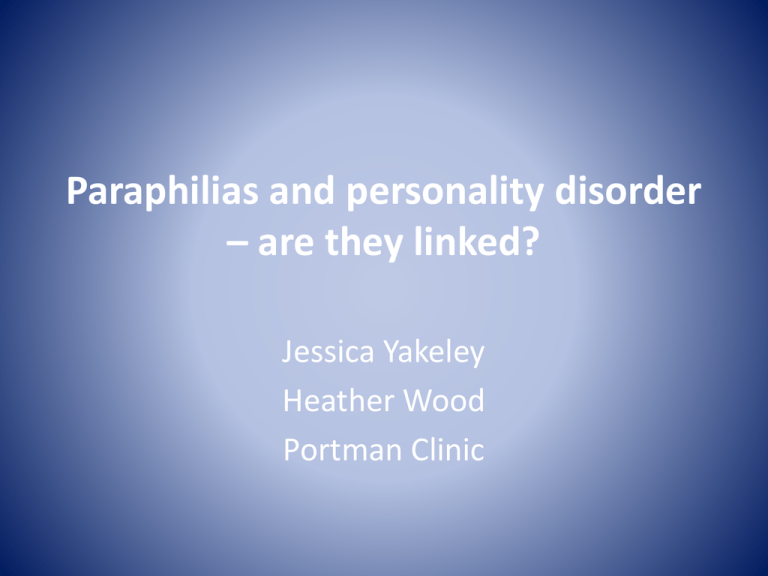
Paraphilias and personality disorder
– are they linked?
Jessica Yakeley
Heather Wood
Portman Clinic
The Portman Clinic
DSM-IV Diagnosis of Paraphilias
A group of psychosexual disorders characterized
by recurrent, intense sexually arousing fantasies,
sexual urges or behaviors generally involving
1) nonhuman objects,
2) the suffering or humiliation of oneself or one’s
partner, or
3) children or other non-consenting persons that
occur over the period of at least six months.
DSM-IV Diagnosis Paraphilias
•
•
•
•
•
•
•
•
•
Exhibitionism
Fetishism
Frotteurism
Pedophilia
Sexual masochism
Sexual sadism
Transvestic fetishism
Voyeurism
Paraphilia NOS – includes telephone scatologia (obscene
phone calls), necrophilia (corpses), partialism (exclusive
focus on part of body), zoophilia (animals), coprophilia
(faeces), klismaphilia (enemas), and urophilia (urine).
paraphilias
Legal –
e.g fetishism,
Coprophilia,
cross dressing
Ego dystonic
Ego syntonic
-Subjective experience
of compulsion,
adverse consequences
Illegal if enacted e.g.
Paedophilia,
voyeurism,
exhibitionism
Ego syntonic
CJS
Ego dystonic –
CJS + psychother?
History of the paraphilia construct
• ‘Paraphilia’ first apeared in English in 1925 in translation of
Stekel’s Sexual Aberrations – less pejorative than
‘perversion’
• DSM-I (1952) - classified as ‘sexual deviations’ under
personality disorder category (sociopathic personality
disturbance)
• DSM-II (1968) – sexual deviations separated from
personality disorders
• DSM-III (1980) ‘Paraphilia’ replaced ‘sexual deviation’, now
category of ‘psychosexual disorders’. Sexual orientation
disturbance (homosexuality) removed.
• DSM-IV (1994) Paraphilias included in broader category –
‘sexual and gender identity disorders’
Problems with DSM diagnosis of
paraphilias
• Poor reliability and validity
• Ethical and socio-political problems in equating
particular sexual interests with psychopathology
• Patients often fulfill diagnostic criteria for several
different paraphilias concurrently or
longitudinally
• Focus on unusual or problematic sexual fantasies
and behaviours
• Confusion regarding relationship with criminality
Our criticisms of DSM IV
• Paraphilias Axis 1 disorders
• But can involve pervasive sexualisation of
interpersonal relationships
• Quality of attachments often of “exciting hatred /
hostility” rather than true ambivalence
• Wide ranging symptomatic enactments of sexually
deviant behaviours
• Disturbance of sense of self – often highly selfcritical, sense of self-disgust, shame
Portman model of paraphilias
• Use of sexualisation as a form of manic
defence
• Fusion of sexualisation and aggression
• Defends against anxieties aroused by intimacy:
claustro-agoraphobic, fears of aggression,
anxieties about adequacy
• Bestows a sense of control and triumph
• The sexualised behaviour creates a scenario in
which dreaded situation is often reversed
Portman model of paraphilias
• In mild form – ego-syntonic, sexualisation
gratifying, defensive structure ‘works’ and
there are areas of unimpaired functioning
• In severe form – pervasive disruption of
personality functioning
• Enactment often compounds self-disgust
• Relationships distorted by sexualisation
• Actual or imagined harm to self and/or others
Do some paraphilias meet criteria for
PD?
• Enduring pattern of inner experience and
behaviour
• Pervasive across a broad range of personal
and social situations
• Leads to clinically significant distress or
impairment
• Stable and of long duration – onset can be
traced back to at least adolescence or early
adulthood
DSM-V proposals for paraphilias
• Paraphilias remain under sexual and gender
identity disorder category
• New distinction between ‘paraphilia’ and
‘paraphilic disorder’
• Introduce new disorder ‘paraphilic coercive
disorder’
• Expand pedophilia to ‘pedohebephilic
disorder to include increase range of target
children, and child pornography
Research on relationship between
paraphilias and personality disorders
• Remarkably little clinical literature on
paraphilias
• Few studies have examined prevalence of
personality disorders in paraphilias
• Most studies are of sex offenders, particularly
child molesters, and do not distinguish
paraphilic from non-paraphilic samples
• Samples usually post-conviction
• Sex offenders have high levels of psychiatric comorbidity, both axis 1 and axis 2 conditions
Relationship between paraphilias
and personality disorders
• Dunsieth et al (2004) in study of 113 men convicted of sexual
offenses showed paraphilia correlated with avoidant
personality disorder
• Leue et al (2004) in study of 55 sex offenders showed
correlation with cluster B and cluster C pd, social phobia more
common in paraphilic offenders
• Bogaerts et al (2006) found higher rates of depressive and
avoidant pds in sample of 33 exhibitionists compared to 33
matched controls
• Bogaerts et al (2008) – presence of obsessive compulsive
personality disorder distinguished paraphilic from nonparaphilic child molesters
What is the possible relationship between
paraphilias and personality disorders?
• A. No relationship
• B. Co-morbidity
• C. Personality disorder a contributory factor in the
aetiology or expression of the paraphilia
• D. Paraphilia pervades relating to self and others and
is, in effect, a form of personality disorder
Portman exploratory studies
• 1. Use of a clinician-rated measure of
personality (SWAP) as part of outcome
monitoring of all patients accepted for
treatment – N=44 with paraphilias
• 2. Self-report measures (MCMI) of a cohort of
child sex offenders offered group
psychotherapy
The Shedler-Westen Assessment
Procedure-200 (SWAP-200)
• Clinician-rated assessment measure of personality disorders
• Q-sort method of prototype matching 200 statements, each
describing a different aspect of personality or psychological
functioning
• Produces profile of personality disorders and traits matched
to formal DSM-IV Axis II diagnoses, as well as a set of more
psychoanalytically-informed SWAP personality syndromes
• Good reliability and validity for both non-forensic and forensic
populations
• Excel-based programme, 45 minutes for the clinician to
complete
SWAP Analysis
• PD t scores – match the patient to prototypical
personality descriptions corresponding to
DSM IV TR
• Factor (trait) t scores – 12 underlying factors
derived by factor analysis, including
psychological health, emotional dysregulation,
oedipal conflict, dissociation and sexual
conflict
Proportion of paraphilic patients with PD diagnoses [n=44]
7%
25%
PDTScores over 60
.00
1.00
2.00
3.00
2
%
66%
34% meet
criteria for
PD
34%
meet
criteria
for PD
Proportion of paraphilic pts with PD
diagnoses or traits (n=44)
PDTScores
.00
1.00
2.00
3.00
4.00
5.00
6.00
7
%
48%
16%
18%
52% meet
criteria for
PD or traits
of PD
PD T scores >1
n=44
PD T scores – PD and traits >1
n=44
Factor T scores
n=44
38% have sexual conflict
20% have sexual conflict
+ oedipal conflict
16% have sexual +
oedipal conflict +
dissociation
Factor 12 sexual conflict
• Appears to associate sexual activity with danger
• Tends to feel guilty or ashamed about his or her
sexual interests or activities
• Tends to see sexual activities as somehow revolting
or disgusting
• Experiences a specific sexual dysfunction during
intercourse or attempts at intercourse
• When romantically or sexually attracted, tends to
lose interest if the other person reciprocates
• Has difficulty directing both tender feelings and
sexual feelings towards the same person
Summary of Portman SWAP study
• 34% of pts with paraphilias meet criteria for
PD
• 52% meet criteria for PD or traits of PD
• Type of PD notably varied – schizoid,
borderline, o-c, passive – aggressive
• plus avoidant traits
• Factor T scores suggest a slightly more
coherent syndrome: sexual conflicts,
dissociation and oedipal conflicts
Evaluation of a treatment group for
convicted child sex offenders
•
•
•
•
Baseline n=9
MCMI
Risk measures (Static 99 +)
AAI + additional offence-related
questions
(rated for attachment status and RF)
PD scores of CS offenders on MCMI
n=9
70%
definite
60%
probable
50%
40%
Definite
presence of PD
in 78%
30%
20%
Probable
presence of PD in
100%
10%
0%
schizoid
antisocial
borderline
avoidant
dependent
Comparison of Bracton [Craissati, Webb and Keen,
2007] and Portman samples – probable presence
of PD by rank
Portman
Bracton
1. Avoidant (67%)
1. Avoidant (39%)
2= Dependent (56%)
2. Dependent (39%)
2= Schizoid (56%)
3. Schizoid (33%)
4= Borderline (33%)
4. Borderline (12%)
4= Antisocial (33%)
5. Paranoid (10%)
Definite presence of PD by cluster
Portman
Bracton
Cluster A
44%
40%
Cluster B
22%
26%
Cluster C
44%
59%
2+ clusters
present
33%
20%
Is this a low-risk sample?
Static 99
Portman (n=9)
Bracton (n=160)
2 (22%)
56 (35%)
Medium low
0
51 (32%)
Medium high
3 (33%)
36 (22%)
High
4 (44%)
19 (12%)
Low
Portman sample cf Hall and Hall
review of paedophilia [2007, Mayo Clinic Proc,
82 (4) 457-471]
Hall and Hall
Portman
Affective illness
60-80%
Anxiety disorder
50-60%
67%
Lifetime
diagnosable PD
Cluster A PD
70-80%
?%
18%
44%
Cluster B PD
33%
22%
Cluster C PD
43%
44%
Portman group
• High rates of PD and multiple personality
disorders
• Profile of avoidant, dependent and
schizoid individuals
• High levels of anxiety (67% with clinical
syndrome)
Clinical implications
• Severe difficulties in relation to adult
intimacy
• Anxious not psychopathic
• Identification with (child’s?) dependency
and vulnerability
Attachment status of CS offenders
4
3.5
3
2.5
2
Portman
Broadmoor
1.5
1
0.5
0
cannot
classify
dismissive
preoccupied
secure
unorganised
Correlation of attachment style with
PD in CSA sample
• All those with dismissive attachment
style, definite avoidant PD
• All those with preoccupied attachment
style have borderline traits
RF scores comparing AAI and forensic
questions
Paired
samples t-test
T=3.54
P<0.01
R
F
Forensic
RF
What is the relationship between
paraphilias and personality disorder?
A. No relationship
B. Co-morbidity
All paraphilic pts in
SWAP study
CSA group on
MCMI
48% with no
traits of PD
34%
0% with no
traits
78%
[reaching criterion for PD]
C. PD contributes to
clinical syndrome
D. Paraphilia is, in
effect, a form of PD
52% with traits of 100% with
PD
probable PD
16% with sexual +
100%?
oedipal conflicts +
dissociation
Thanks to…..
• Assistant psychologists:
•
•
•
•
•
Ros Watts
Susie Rudge
Phil Lurie
Alexa Byrne
Meera Desai
• And to Gill McGauley for Broadmoor data
and use of AAI forensic questions
Contact us:
• jyakeley@tavi-port.nhs.uk
• hwood@tavi-port.nhs.uk

